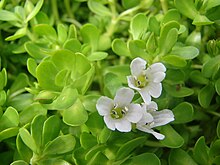Bacopa
| Bacopa | |
|---|---|
 | |
| Bacopa monnieri | |
| Scientific classification | |
| Kingdom: | Plantae |
| Clade: | Tracheophytes |
| Clade: | Angiosperms |
| Clade: | Eudicots |
| Clade: | Asterids |
| Order: | Lamiales |
| Family: | Plantaginaceae |
| Tribe: | Gratioleae |
| Genus: | Bacopa Aubl. (1775), nom. cons.[1] |
| Species[2] | |
| 60; see text | |
| Synonyms[2] | |
| |
Bacopa is a genus of 60 aquatic plants belonging to the family Plantaginaceae. It is commonly known as waterhyssop (or water hyssop, though this is more misleading as Bacopa is not very closely related to hyssop but simply has a somewhat similar appearance).
Description

They are annual or perennial, with decumbent or erect stems. The leaves are opposite or whorled, and sessile. The leaf blade is regular, round to linear, and the venation is palmate or pinnate. Its stems are hairy or smooth. The flowers are produced solitary or in pairs from leaf axils, usually radially symmetrical, with five sepals and five petals, and they are usually white, blue, or purple. Dispersal and propagation is by seeds and stem fragments. Crushed leaves have a distinctive 'lemon' scent.

Habitat and range
Bacopa species are found in tropical and subtropical regions of the world, particularly the Americas. A few are regarded as weeds and excess stock should not be dumped in warmer regions. Most grow in moist amphibious conditions, though some like B. myriophylloides seem to be wholly aquatic.
Uses
Bacopa monnieri is used in Ayurvedic medicine.[citation needed] Preliminary clinical research found that the herb may improve cognition.[3][4][5]
Cultivation
Some of these species are commonly used in freshwater aquariums and ponds in warmer climates. Most are easy to grow and will tolerate a wide range of conditions. B. monnieri will tolerate brackish water up to 15 ppt, due to specialized adaptations that enable it to survive in saline environments. Algal infestation can be a problem in brighter lighting conditions.[6][7][8]
Species
60 species are accepted.[2]
|
|
Formerly placed here
- Mecardonia procumbens (Mill.) Small (as B. procumbens (Mill.) Greenm.)[9]
See also
- Chaenostoma cordatum syn. Sutera cordata, a plant also known by the obsolete name Bacopa.
References


- ^ "Genus: Bacopa Aubl". Germplasm Resources Information Network. United States Department of Agriculture. 5 October 2007. Retrieved 18 January 2011.
- ^ a b c Bacopa Aubl. Plants of the World Online. Retrieved 14 May 2024.
- ^ Aguiar, Sebastian; Borowski, Thomas (2013). "Neuropharmacological review of the nootropic herb Bacopa monnieri". Rejuvenation Research. 16 (4): 313–326. doi:10.1089/rej.2013.1431. ISSN 1557-8577. PMC 3746283. PMID 23772955.
- ^ Kongkeaw, C; Dilokthornsakul, P; Thanarangsarit, P; Limpeanchob, N; Norman Scholfield, C (2014). "Meta-analysis of randomized controlled trials on cognitive effects of Bacopa monnieri extract". Journal of Ethnopharmacology. 151 (1): 528–35. doi:10.1016/j.jep.2013.11.008. PMID 24252493.
- ^ Neale, Chris; Camfield, David; Reay, Jonathon; Stough, Con; Scholey, Andrew (5 February 2013). "Cognitive effects of two nutraceuticals Ginseng and Bacopa benchmarked against modafinil: a review and comparison of effect sizes". British Journal of Clinical Pharmacology. 75 (3): 728–737. doi:10.1111/bcp.12002. ISSN 0306-5251. PMC 3575939. PMID 23043278.
- ^ Ali, G.; Srivastava, P.S.; Iqbal, M. (1999). "Proline Accumulation, Protein Pattern and Photosynthesis in Bacopa Monniera Regenerants Grown under Na Cl Stress". Biologia Plantarum. 42: 89–95. doi:10.1023/A:1002127711432. S2CID 30418903.
- ^ "Histological and Morphological Responses of Bacopa Monnieri (L.) Pennell in Glycophytic and Halophytic Conditions | International Journal of Pharmaceutical Sciences and Research". 31 December 2018.
- ^ Native Plants Hawaii. "Bacopa monnieri". Retrieved 19 July 2012.
- ^ a b c "GRIN Species Records of Bacopa". Germplasm Resources Information Network. United States Department of Agriculture. Retrieved 18 January 2011.
- ^ a b "Bacopa". Integrated Taxonomic Information System. Retrieved 18 January 2011.










